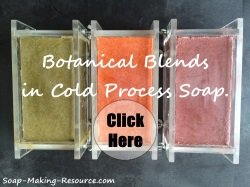Hand Milled Soap Tutorial
On this page, I will teach you how to use the hand milled soap making method (also known as the rebatching soap making method) to create custom soaps at home.
The basic process involves five simple steps.
1. Make a plain soap base from scratch using the cold process method or hot process method but do not add any extra essential oils, dyes, or nutrients. In other words, create your initial soap using only the ingredients that actually take part in the saponification reaction.
By the end of this initial stage you should have made a basic, pure, unscented soap base with no other additions. Note that some soap makers do add some of the extra ingredients during the cold process procedure, but most add them later on in the milled soap process.
2. After the soap base is fully hardened, grate it into small pieces and melt in a microwave, crock-pot, or double boiler. You may want to put the grated soap in a heat resistant heavy duty plastic bag so that you can snip off the end for easy dispensing. This also allows you to easily mix the extra nutrients added into the soap by kneading the soap within the bag.
Remember, if you did not wait for the soap to fully cure, it can still be somewhat caustic. So make sure you follow these soap making safety guidelines!
3. Once the soap base is liquefied, add the essential oils, soap dye and various nutrients and mix the concoction until the soap is one solid color.
4. Now pour the soap into a pre-designed soap making mold, or wooden loaf soap mold to harden.
5. After the soap bars are solid, take them out of the mold and lay them on a rack to further cure.
6. Before using hand milled soap, or any homemade soap for that matter, always test the PH levels to make sure the soap is completely safe.
My Thoughts about Rebatching Soap
In order to actually use the rebatching soap making method, obviously, you must know how to create soap from scratch first...
That being said, why would you make hand milled soaps? If you know the cold process method or hot process method why not just add the extra ingredients during the correct stages of that soap making procedure?
|
Sign Up Today!
*Your information is SAFE with us! |
Well, there are three main benefits of hand milled soap making:
- It's a great way to save money and reduce waste by re-melting botched soap making projects and turning them into completely unique rebatched soap just by adding a couple new ingredients.
- With the rebatching method, you can actually get your kids involved in the soap making process. This method is much safer for children because during the rebatching stage, the lye is no longer being used.
- You can use this method if you have some older soap that no longer retains their intended scent. Depending on the essential oils used, this can happen quite often, especially if you make larger batches that just tend to sit around. Simply re-melt, re-scent, and let it re-harden. Your soap will be good as new!
Now that you understand how to make rebatched soap, continue to browse this site and learn all there is to know about every aspect of soap making. You're going to have a blast!
Return from the hand milled soap tutorial to how to make soap
Return from the rebatching soap tutorial to the soap making resource home page.











